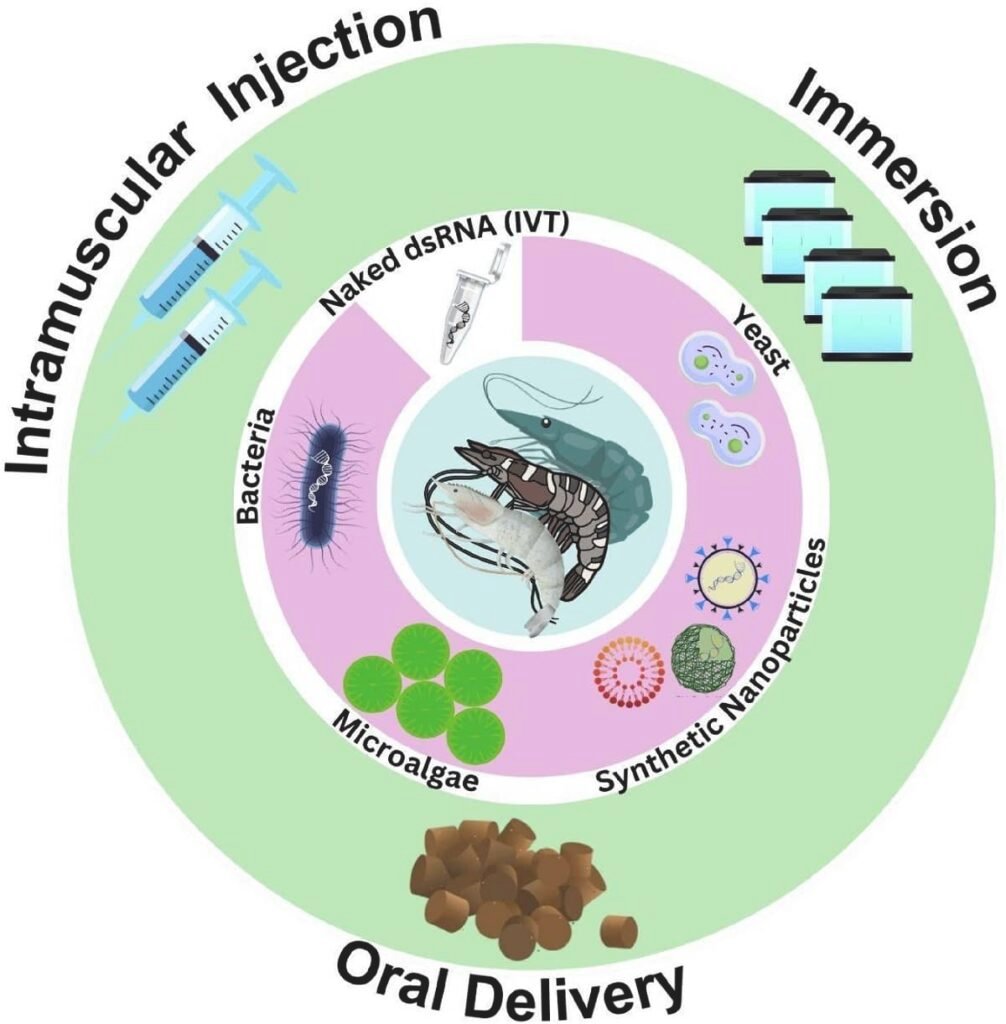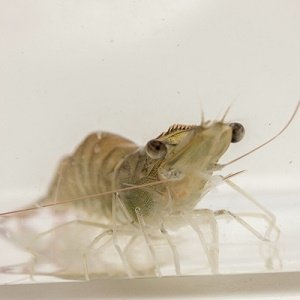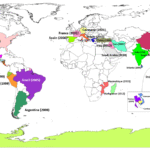
Shrimp aquaculture, a cornerstone of global economic growth, faces a constant threat from viral diseases that can decimate entire production cycles within days. White Spot Syndrome Virus (WSSV) is undoubtedly the most feared pathogen, capable of causing mortality rates of up to 100%. In response to this challenge, science is pursuing solutions beyond traditional methods. Among the most promising technologies is RNA interference (RNAi), a gene-silencing strategy that acts as a molecular “switch,” capable of turning off specific viral genes to prevent their replication.
However, the primary challenge is not merely designing the correct RNAi molecule but delivering it to the target site within the shrimp practically and cost-effectively. A recent review article published in Fish and Shellfish Immunology by scientists from Mindanao State University and the University of Santo Tomas thoroughly explores the advancements in RNAi delivery systems. The study compares various platforms, from bacteria and algae to nanoparticles, outlining the path forward for this technology to move from the laboratory to commercial ponds.
Key conclusions
- 1 Key conclusions
- 2 What is gene silencing or RNAi?
- 3 The challenge is not the what, but the how: RNAi delivery
- 4 Delivery vehicles: Who carries the RNAi message?
- 5 From the lab to the pond? The challenges for real-world application
- 6 Conclusion: A promising future that requires further research
- 7 Entradas relacionadas:
- RNA interference (RNAi) technology is a promising and highly specific tool for silencing key viral genes (such as those in WSSV) or shrimp genes that viruses require for replication.
- Although the injection of double-stranded RNA (dsRNA) molecules is effective in a laboratory setting, it is unfeasible on a commercial scale. The future of RNAi in shrimp farming hinges on efficient oral delivery systems.
- Biological delivery systems, such as bacteria (probiotics), microalgae, and yeasts engineered to produce dsRNA, offer a scalable and safer route for administration through feed.
- Synthetic nanoparticles (like VLPs and chitosan complexes) demonstrate the highest protection efficacy and dsRNA stability, but their cost and scalability remain significant challenges for the field.
What is gene silencing or RNAi?
RNAi is a natural defense mechanism found in eukaryotic organisms, including shrimp, to protect against viruses that use double-stranded RNA (dsRNA) in their life cycle. The technology leverages this natural process. By introducing a dsRNA molecule into the shrimp that is designed to match the sequence of a vital viral gene (e.g., the vp28 gene of WSSV), a cellular machinery is activated. This machinery seeks out and destroys the corresponding viral messenger RNA (mRNA). Without this mRNA, the virus cannot produce its essential proteins and, consequently, cannot replicate, stopping the infection in its tracks.
Several molecules can initiate this process:
- dsRNA (double-stranded RNA): Long molecules that are processed by the cell into smaller fragments.
- siRNA (small interfering RNA): Short, specific fragments that are directly loaded into the silencing complex.
- shRNA and lhRNA (short and long hairpin RNA): Molecules expressed within cells from a vector (like a plasmid in a bacterium) and then processed to become active.
The challenge is not the what, but the how: RNAi delivery
Early studies demonstrated the efficacy of RNAi by directly injecting dsRNA into shrimp. While this works in a controlled laboratory environment, it is entirely impractical and cost-prohibitive for the thousands or millions of larvae and juveniles on a commercial farm. Consequently, research has focused on developing methods for mass administration, primarily through oral delivery by incorporating the RNAi into the feed.
For oral administration to be effective, the dsRNA requires a “vehicle” to protect it from degradation in the water and the shrimp’s digestive tract, as well as to facilitate its absorption. This is where innovation is making a crucial difference.
Delivery vehicles: Who carries the RNAi message?
The study comprehensively reviews four main platforms for the oral production and delivery of dsRNA, each with its own set of advantages and disadvantages.
Bacteria: Living dsRNA factories
The use of genetically modified bacteria is one of the most cost-effective and scalable methods. Strains of Escherichia coli (such as the RNase-deficient HT115) or probiotics like Bacillus subtilis and Lactobacillus plantarum are used to produce large quantities of virus-specific dsRNA. These bacteria, often inactivated, can be directly incorporated into the feed.
Stay Always Informed
Join our communities to instantly receive the most important news, reports, and analysis from the aquaculture industry.
- Advantages: Low production cost and high scalability. Probiotics also offer additional benefits to the shrimp’s gut health.
- Disadvantages: The stability of the dsRNA once ingested can be limited. Furthermore, the use of genetically modified E. coli faces regulatory and public perception hurdles.
Microalgae: A nutritious and safe vehicle
Microalgae, such as Chlamydomonas reinhardtii, represent a highly attractive alternative. They are a natural component of the shrimp’s diet, are rich in nutrients, and are considered safe (GRAS status). They can be genetically engineered to produce dsRNA in their chloroplasts. The shrimp ingests the entire algal biomass, which acts as a natural capsule.
- Advantages: They are safe, nutritious, and do not face the same regulatory resistance as bacteria.
- Disadvantages: The cell walls of some algae can be difficult to digest, potentially limiting the release and efficiency of the dsRNA in the shrimp’s gut.
Yeasts: Another biosecure option
Similar to microalgae, yeasts like Yarrowia lipolytica are a safe platform (GRAS) and have been used as immunostimulants in aquaculture. They are bioengineered to produce dsRNA against WSSV, reducing viral gene expression in shrimp fed with them.
- Advantages: GRAS status and minimal environmental risk.
- Disadvantages: The protection reported thus far has been moderate (~25% reduction in viral gene expression), and the strategy still requires optimization.
Synthetic nanoparticles: High-tech to the rescue
This is the most advanced field and offers the greatest protection. It involves encapsulating dsRNA in nanometer-sized particles that shield it from degradation and enhance its cellular uptake.
- Virus-Like Particles (VLPs): These are empty, non-infectious viral capsids that can be filled with dsRNA. By mimicking a real virus, they trick shrimp cells into internalizing them, achieving highly efficient delivery. Up to 100% survival has been reported in WSSV-challenged shrimp following the injection of dsRNA-loaded VLPs.
- Polymeric and Lipid Nanoparticles: Materials such as chitosan (a derivative of crustacean shells) or liposomes can form complexes with dsRNA, protecting it and facilitating its entry into cells. Studies show survival rates of up to 80-95%.
- Advantages: Maximum dsRNA stability and very high delivery efficiency.
- Disadvantages: The production cost is significantly higher, and large-scale application in feed is more complex and expensive than biological options.
From the lab to the pond? The challenges for real-world application
Despite these advancements, the transition of RNAi into a commercial tool faces three major obstacles:
- Production cost: Although it has dropped dramatically (from >$300/mg with laboratory methods to <$50/mg with bacterial systems), cost remains a limiting factor for mass use.
- Field stability: dsRNA is a fragile molecule that degrades rapidly in pond water due to microbes, enzymes, and UV light. An effective delivery vehicle must ensure its stability not only during feed manufacturing but also in the aquatic environment.
- Dosage standardization: It is very difficult to determine how much dsRNA each shrimp actually consumes in a pond. Optimizing the oral dose to ensure a sustained protective effect under variable field conditions (temperature, salinity, etc.) is a critical challenge.
Conclusion: A promising future that requires further research
RNAi technology has the potential to transform health management in shrimp farming, offering a specific and potent defense against the most devastating viral diseases. Research has proven that the “what” (gene silencing) works. The focus now is on perfecting the “how” (delivery).
Oral delivery systems, especially those based on biosecure platforms like probiotics, microalgae, and yeasts, appear to be the most viable and sustainable path for large-scale application. Nanoparticles, while more expensive, represent the “gold standard” in efficacy and could be key for high-value applications, such as in broodstock or during critical production phases. The essential next step is to advance these technologies into field trials under real-world conditions and to develop a clear regulatory framework that guarantees their safety and environmental sustainability for widespread adoption.
The study was funded by the Department of Science and Technology – Philippine Council for Agriculture, Aquatic and Natural Resources Research and Development (DOST-PCAARRD) under the project titled “Targeting Essential Genes Utilizing RNA Interference to Mitigate WSSV in Tiger Shrimp.”
Contact
Mary Beth B. Maningas
Research Center for Natural and Applied Sciences, University of Santo Tomas
Manila, Philippines.
Email: mbmaningas@ust.edu.ph
Reference
Pedrosa-Gerasmio, I. R., Saquilayan, K. M. D., Glori, P. J. V., Almazan, D. J. D. N., Solitario, J. T. A., & Maningas, M. B. B. (2025). A comparative review of RNAi delivery systems for shrimp aquaculture and future directions. Fish & Shellfish Immunology, 167, 110877. https://doi.org/10.1016/j.fsi.2025.110877
Editor at the digital magazine AquaHoy. He holds a degree in Aquaculture Biology from the National University of Santa (UNS) and a Master’s degree in Science and Innovation Management from the Polytechnic University of Valencia, with postgraduate diplomas in Business Innovation and Innovation Management. He possesses extensive experience in the aquaculture and fisheries sector, having led the Fisheries Innovation Unit of the National Program for Innovation in Fisheries and Aquaculture (PNIPA). He has served as a senior consultant in technology watch, an innovation project formulator and advisor, and a lecturer at UNS. He is a member of the Peruvian College of Biologists and was recognized by the World Aquaculture Society (WAS) in 2016 for his contribution to aquaculture.




